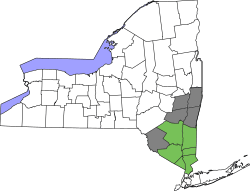Mohawk people
The Mohawk people (Mohawk: Kanienʼkehá꞉ka[1]) are the most easterly tribe of the Haudenosaunee, or Iroquois Confederacy. They are an Iroquoian-speaking indigenous people of North America, with communities in northern New York State and southeastern Canada, primarily around Lake Ontario and the St Lawrence River. As one of the five original members of the Iroquois League, the Mohawk are known as the Keepers of the Eastern Door – the traditional guardians of the Iroquois Confederation against invasions from the east.
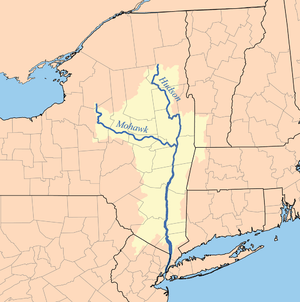
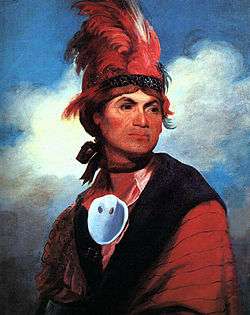 | |
| Regions with significant populations | |
|---|---|
| 23,682 | |
| 5,632 | |
| Languages | |
| English, Mohawk, French, Formerly: Dutch, Mohawk Dutch | |
| Religion | |
| Karihwiio, Kanohʼhonʼio, Kahniʼkwiʼio, Christianity, Longhouse, Handsome Lake, Other Indigenous Religion | |
| Related ethnic groups | |
| Seneca Nation, Oneida Nation, Cayuga Nation, Onondaga Nation, Tuscarora Nation, other Iroquoian peoples | |
Historically, the Mohawk people were originally based in the valley of the Mohawk River in present-day upstate New York, west of the Hudson River. Their territory ranged north to the St. Lawrence River, southern Quebec and eastern Ontario; south to greater New Jersey and into Pennsylvania; eastward to the Green Mountains of Vermont; and westward to the border with the Iroquoian Oneida Nation's traditional homeland territory.
Mohawk communities
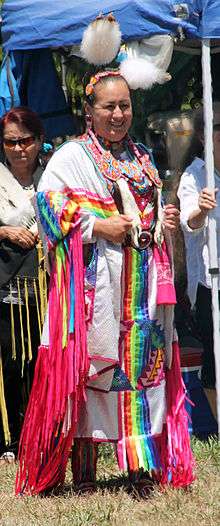
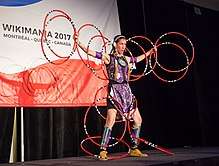
Members of the Mohawk tribe now live in settlements in northern New York State and southeastern Canada. Many Mohawk communities have two sets of chiefs, who are in some sense competing governmental rivals. One group are the hereditary chiefs nominated by Clan Mother matriarchs in the traditional Mohawk fashion. Mohawk of most of the reserves have established constitutions with elected chiefs and councilors, with whom the Canadian and U.S. governments usually prefer to deal exclusively. The self-governing communities are listed below, grouped by broad geographical cluster, with notes on the character of community governance found in each.
- Northern New York:
- Kanièn꞉ke (Ganienkeh) "Place of the flint". Traditional governance.
- Kanaʼtsioharè꞉ke "Place of the washed pail". Traditional governance.
- Along the St Lawrence in Quebec:
- Ahkwesásne (St. Regis, New York and Quebec/Ontario, Canada) "Where the partridge drums". Traditional governance, band/tribal elections.
- Kahnawà꞉ke (south of Montréal) "On the rapids". Canada, traditional governance, band/tribal elections.
- Kaʼnehsatà꞉ke (Oka) "Where the snow crust is". Canada, traditional governance, band/tribal elections.
- Southern Ontario:
- Kenhtè꞉ke (Tyendinaga) "On the bay". Traditional governance, band/tribal elections.
- Wáhta (Gibson) "Maple tree". Traditional governance, band/tribal elections.
- Ohswé꞉ken “Six Nations of the Grand River”. Traditional governance, band/tribal elections. The Mohawk form the majority of the population of this Iroquois Six Nations reserve. There are also Mohawk Orange Lodges in Canada.
Given increased activism for land claims, a rise in tribal revenues due to establishment of gaming on certain reserves or reservations, competing leadership, traditional government jurisdiction, issues of taxation, and the Indian Act, Mohawk communities have been dealing with considerable internal conflict since the late 20th century.
History
First contact with European settlers
In the Mohawk language, the people say that they are from Kanienʼkehá꞉ka ("people of the flint"). The Mohawk became wealthy traders as other nations in their confederacy needed their flint for tool making. Their Algonquian-speaking neighbors (and competitors), the people of Muh-heck Haeek Ing ("food area place"), the Mohicans, referred to the people of Ka-nee-en Ka as Maw Unk Lin, meaning "bear people". The Dutch heard and wrote this term as Mohawk, and also referred to the Mohawk as Egil or Maqua.
The French colonists adapted these latter terms as Aignier and Maqui, respectively. They also referred to the people by the generic Iroquois, a French derivation of the Algonquian term for the Five Nations, meaning "the snake people". The Algonquians and Iroquois were traditional competitors and enemies.
In the upper Hudson and Mohawk Valley regions, the Mohawk long had contact with the Algonquian-speaking Mahican people, who occupied territory along the Hudson River, as well as other Algonquian and Iroquoian tribes to the north around the Great Lakes. The Mohawk had extended their own influence into the St. Lawrence River Valley, which they maintained for hunting grounds. They are believed to have defeated the St. Lawrence Iroquoians in the 16th century, and kept control of their territory. In addition to hunting and fishing, for centuries the Mohawk cultivated productive maize fields on the fertile floodplains along the Mohawk River, west of the Pine Bush.
In the seventeenth century the Mohawk encountered both the Dutch, who went up the Hudson River and established a trading post in 1614 at the confluence of the Mohawk and Hudson rivers, and the French, who came south into their territory from New France (present-day Quebec). The Dutch were primarily merchants and the French also conducted fur trading. During this time the Mohawk fought with the Huron in the Beaver Wars for control of the fur trade with the Europeans. Their Jesuit missionaries were active among First Nations and Native Americans, seeking converts to Catholicism.
In 1614, the Dutch opened a trading post at Fort Nassau, New Netherland. The Dutch initially traded for furs with the local Mahican, who occupied the territory along the Hudson River. Following a raid in 1626 when the Mohawk resettled along the south side of the Mohawk River,[2]:pp.xix–xx in 1628, they mounted an attack against the Mahican, pushing them back to the area of present-day Connecticut. The People of Ka-nee-en Ka (Mohawks) gained a near-monopoly in the fur trade with the Dutch by prohibiting the nearby Algonquian-speaking tribes to the north or east to trade with them but did not entirely control this.
European contact resulted in a devastating smallpox epidemic among the Mohawk in 1635; this reduced their population by 63%, from 7,740 to 2,830, as they had no immunity to the new disease. By 1642 they had regrouped from four into three villages, recorded by Catholic missionary priest Isaac Jogues in 1642 as Ossernenon, Andagaron, and Tionontoguen, all along the south side of the Mohawk River from east to west. These were recorded by speakers of other languages with different spellings, and historians have struggled to reconcile various accounts, as well as to align them with archeological studies of the areas. For instance, Johannes Megapolensis, a Dutch minister, recorded the spelling of the same three villages as Asserué, Banagiro, and Thenondiogo.[2] Late 20th-century archeological studies have determined that Ossernenon was located about 9 miles west of the current city of Auriesville; the two were mistakenly conflated by a tradition that developed in the late 19th century in the Catholic Church.[3][4]
While the Dutch later established settlements in present-day Schenectady and Schoharie, further west in the Mohawk Valley, merchants in Fort Nassau continued to control the fur trading. Schenectady was established essentially as a farming settlement, where Dutch took over some of the former Mohawk maize fields in the floodplain along the river. Through trading, the Mohawk and Dutch became allies of a kind.
During their alliance, the Mohawks allowed Dutch Protestant missionary Johannes Megapolensis to come into their tribe and teach the Christian message. He operated from the Fort Nassau area about six years, writing a record in 1644 of his observations of the Mohawk, their language (which he learned), and their culture. While he noted their ritual of torture of captives, he recognized that their society had few other killings, especially compared to the Netherlands of that period. [5] [6]
The trading relations between the Mohawk and Dutch helped them maintain peace even during the periods of Kieft's War and the Esopus Wars, when the Dutch fought localized battles with other tribes. In addition, Dutch trade partners equipped the Mohawk with guns to fight against other First Nations who were allied with the French, including the Ojibwe, Huron-Wendat, and Algonquin. In 1645 the Mohawk made peace for a time with the French, who were trying to keep a piece of the fur trade.[7]
During the Pequot War (1634–1638), the Pequot and other Algonquian Indians of coastal New England sought an alliance with the Mohawk against English colonists of that region. Disrupted by their losses to smallpox, the Mohawk refused the alliance. They killed the Pequot sachem Sassacus who had come to them for refuge.
In the winter of 1651, the Mohawk attacked to the southeast and overwhelmed the Algonquian in the coastal areas. They took between 500-600 captives. In 1664, the Pequot of New England killed a Mohawk ambassador, starting a war that resulted in the destruction of the Pequot, as the English and their allies in New England entered the conflict, trying to suppress the Native Americans in the region. The Mohawk also attacked other members of the Pequot confederacy, in a war that lasted until 1671.
In 1666, the French attacked the Mohawk in the central New York area, burning the three Mohawk villages south of the river and their stored food supply. One of the conditions of the peace was that the Mohawk accept Jesuit missionaries. Beginning in 1669, missionaries attempted to convert Mohawk to Christianity, operating a mission in Ossernenon 9 miles west[3][4] of present-day Auriesville, New York until 1684, when the Mohawk destroyed it, killing several priests.
Over time, some converted Mohawk relocated to Jesuit mission villages established south of Montreal on the St. Lawrence River in the early 1700s: Kahnawake (used to be spelled as Caughnawaga, named for the village of that name in the Mohawk Valley) and Kanesatake. These Mohawk were joined by members of other tribes but dominated the settlements by number. Many converted to Roman Catholicism. In the 1740s, Mohawk and French set up another village upriver, which is known as Akwesasne. Today a Mohawk reserve, it spans the St. Lawrence River and present-day international boundaries to New York, United States, where it is known as the St. Regis Mohawk Reservation.
Kateri Tekakwitha, born at Ossernenon in the late 1650s, has become noted as a Mohawk convert to Catholicism. She moved with relatives to Caughnawaga on the north side of the river after her parents' deaths.[2] She was known for her faith and a shrine was built to her in New York. In the late 20th century, she was beatified and was canonized in October 2012 as the first Native American Catholic saint. She is also recognized by the Episcopal and Lutheran churches.
After the fall of New Netherland to England in 1664, the Mohawk in New York traded with the English and sometimes acted as their allies. During King Philip's War, Metacom, sachem of the warring Wampanoag Pokanoket, decided to winter with his warriors near Albany in 1675. Encouraged by the English, the Mohawk attacked and killed all but 40 of the 400 Pokanoket.
From the 1690s, Protestant missionaries sought to convert the Mohawk in the New York colony. Many were baptized with English surnames, while others were given both first and surnames in English.
During the late seventeenth and early eighteenth centuries, the Mohawk and Algonquian and Abenaki tribes in New England were involved in raids conducted by the French and English against each other's settlements during Queen Anne's War and other conflicts. They conducted a growing trade in captives, holding them for ransom. Neither of the colonial governments generally negotiated for common captives, and it was up to local European communities to raise funds to ransom their residents. In some cases, French and Abenaki raiders transported captives from New England to Montreal and the Mohawk mission villages. The Mohawk at Kahnawake adopted numerous young women and children to add to their own members, having suffered losses to disease and warfare. For instance, among them were numerous survivors of the more than 100 captives taken in the Deerfield raid in western Massachusetts. The minister of Deerfield was ransomed and returned to Massachusetts, but his daughter was adopted by a Mohawk family and ultimately assimilated and married a Mohawk man.[8]
During the era of the French and Indian War (also known as the Seven Years' War), Anglo-Mohawk partnership relations were maintained by men such as Sir William Johnson in New York (for the British Crown), Conrad Weiser (on behalf of the colony of Pennsylvania), and Hendrick Theyanoguin (for the Mohawk). Johnson called the Albany Congress in June 1754, to discuss with the Iroquois chiefs repair of the damaged diplomatic relationship between the British and the Mohawk, along with securing their cooperation and support in fighting the French,[9] in engagements in North America.
American Revolutionary War
During the second and third quarters of the 18th century, most of the Mohawk in the Province of New York lived along the Mohawk River at Canajoharie. A few lived at Schoharie, and the rest lived about 30 miles downstream at the Tionondorage Castle, also called Fort Hunter. These two major settlements were traditionally called the Upper Castle and the Lower Castle. The Lower Castle was almost contiguous with Sir Peter Warren's Warrensbush. Sir William Johnson, the British Superintendent of Indian Affairs, built his first house on the north bank of the Mohawk River almost opposite Warrensbush and established the settlement of Johnstown.
The Mohawk were among the four Iroquois tribes that allied with the British during the American Revolutionary War. They had a long trading relationship with the British and hoped to gain support to prohibit colonists encroaching into their territory in the Mohawk Valley. Joseph Brant acted as a war chief and successfully led raids against British and ethnic German colonists in the Mohawk Valley, who had been given land by the British administration near the rapids at present-day Little Falls, New York.
A few prominent Mohawk, such as the sachem Little Abraham (Tyorhansera) at Fort Hunter, remained neutral throughout the war.[10] Joseph Louis Cook (Akiatonharónkwen), a veteran of the French and Indian War and ally of the rebels, offered his services to the Americans, receiving an officer's commission from the Continental Congress. He led Oneida warriors against the British. During this war, Johannes Tekarihoga was the civil leader of the Mohawk. He died around 1780. Catherine Crogan, a clan mother and wife of Mohawk war chief Joseph Brant, named her brother Henry Crogan as the new Tekarihoga.
In retaliation for Brant's raids in the valley, the rebel colonists organized Sullivan's Expedition. It conducted extensive raids against other Iroquois settlements in central and western New York, destroying 40 villages, crops and winter stores. Many Mohawk and other Iroquois migrated to Canada for refuge near Fort Niagara, struggling to survive the winter.
After the Revolution
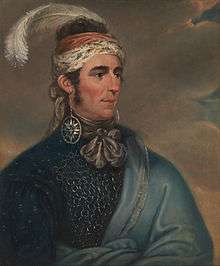
After the American victory, the British ceded their claim to land in the colonies, and the Americans forced their allies, the Mohawk and others, to give up their territories in New York. Most of the Mohawk migrated to Canada, where the Crown gave them some land in compensation. The Mohawk at the Upper Castle fled to Fort Niagara, while most of those at the Lower Castle went to villages near Montreal.
Joseph Brant led a large group of Iroquois out of New York to what became the reserve of the Six Nations of the Grand River, Ontario. Brant continued as a political leader of the Mohawk for the rest of his life. This land extended 100 miles from the head of the Grand River to the head of Lake Erie where it discharges.[11] Another Mohawk war chief, John Deseronto, led a group of Mohawk to the Bay of Quinte. Other Mohawk settled in the vicinity of Montreal and upriver, joining the established communities (now reserves) at Kahnawake, Kanesatake, and Akwesasne.
On November 11, 1794, representatives of the Mohawks (along with the other Iroquois nations) signed the Treaty of Canandaigua with the United States, which allowed them to own land there.
The Mohawk fought as allies of the British against the United States in the War of 1812.
20th century to present
The Mohawk have organized for more sovereignty at their reserves in Canada, pressing for authority over their people and lands. Tensions with the Quebec Provincial and national governments have been strained during certain protests, such as the Oka Crisis in 1990.
In 1993 a group of Akwesasne Mohawk purchased 322 acres of land in the Town of Palatine in Montgomery County, New York which they named Kanatsiohareke. It marked a return to their ancestral land.
Mohawk ironworkers in New York
Mohawk came from Kahnawake and other reserves to work in the construction industry in New York City in the early through the mid-20th century. They had also worked in construction in Quebec. The men were ironworkers who helped build bridges and skyscrapers, and who were called skywalkers because of their seeming fearlessness.[12] They worked from the 1930s to the 1970s on special labor contracts as specialists and participated in building the Empire State Building. The construction companies found that the Mohawk ironworkers did not fear heights or dangerous conditions. Their contracts offered lower than average wages to the First Nations people and limited labor union membership.[13] About 10% of all ironworkers in the US are Mohawks, down from about 15% earlier in the 20th century.[14]
The work and home life of Mohawk ironworkers was documented in Don Owen's 1965 National Film Board of Canada documentary High Steel.[15] The Mohawk community that formed in a compact area of Brooklyn, which they called "Little Caughnawaga", after their homeland, is documented in Reaghan Tarbell's Little Caughnawaga: To Brooklyn and Back, shown on PBS in 2008. This community was most active from the 1920s to the 1960s. The families accompanied the men, who were mostly from Kahnawake; together they would return to Kahnawake during the summers. Tarbell is from Kahnawake and was working as a film curator at the National Museum of the American Indian, located in the former US Customs House in Lower Manhattan.[16]
Since the mid-20th century, Mohawk have also formed their own construction companies. Others returned to New York projects. Mohawk skywalkers had built the World Trade Center buildings that were destroyed during the September 11 attacks, helped rescue people from the burning towers in 2001, and helped dismantle the remains of the building afterwards.[17] Approximately 200 Mohawk iron workers (out of 2000 total iron workers at the site) participated in rebuilding the One World Trade Center in Lower Manhattan. They typically drive the 360 miles from the Kahnawake reserve on the St. Lawrence River in Quebec to work the week in lower Manhattan, and then return on the weekend to be with their families. A selection of portraits of these Mohawk iron workers were featured in an online photo essay for Time Magazine in September 2012.[18]
Contemporary issues
Casinos
Both the elected chiefs and the controversial Warrior Society have encouraged gambling as a means of ensuring tribal self-sufficiency on the various reserves or Indian reservations. Traditional chiefs have tended to oppose gaming on moral grounds and out of fear of corruption and organized crime. Such disputes have also been associated with religious divisions: the traditional chiefs are often associated with the Longhouse tradition, practicing consensus-democratic values, while the Warrior Society has attacked that religion and asserted independence. Meanwhile, the elected chiefs have tended to be associated (though in a much looser and general way) with democratic, legislative and Canadian governmental values.
On October 15, 1993, Governor Mario Cuomo entered into the "Tribal-State Compact Between the St. Regis Mohawk Tribe and the State of New York". The compact allowed the Tribe to conduct gambling, including games such as baccarat, blackjack, craps and roulette, on the Akwesasne Reservation in Franklin County under the Indian Gaming Regulatory Act (IGRA). According to the terms of the 1993 compact, the New York State Racing and Wagering Board, the New York State Police and the St. Regis Mohawk Tribal Gaming Commission were vested with gaming oversight. Law enforcement responsibilities fell under the state police, with some law enforcement matters left to the tribe. As required by IGRA, the compact was approved by the United States Department of the Interior before it took effect. There were several extensions and amendments to this compact, but not all of them were approved by the U.S. Department of the Interior.
On June 12, 2003, the New York Court of Appeals affirmed the lower courts' rulings that Governor Cuomo exceeded his authority by entering into the compact absent legislative authorization and declared the compact void [19] On October 19, 2004, Governor George Pataki signed a bill passed by the State Legislature that ratified the compact as being nunc pro tunc, with some additional minor changes.[20]
In 2008 the Mohawk Nation was working to obtain approval to own and operate a casino in Sullivan County, New York, at Monticello Raceway. The U.S. Department of the Interior disapproved this action although the Mohawk gained Governor Eliot Spitzer's concurrence, subject to the negotiation and approval of either an amendment to the current compact or a new compact. Interior rejected the Mohawk application to take this land into trust.[21]
In the early 21st century, two legal cases were pending that related to Native American gambling and land claims in New York. The State of New York has expressed similar objections to the Dept. of Interior taking other land into trust for federally recognized tribes, which would establish the land as sovereign Native American territory, on which they might establish new gaming facilities.[22] The other suit contends that the Indian Gaming Regulatory Act violates the Tenth Amendment to the United States Constitution as it is applied in the State of New York. In 2010 it was pending in the United States District Court for the Western District of New York.[23]
Culture
Religion
Traditional Mohawk religion is mostly Animist. "Much of the religion is based on a primordial conflict between good and evil."[24] Many Mohawk continue to follow the Longhouse Religion.
In 1632 a band of Jesuit missionaries now known as the Canadian Martyrs led by Isaac Jogues was captured by a party of Mohawks and brought to Ossernenon (now Auriesville, New York). Jogues and company attempted to convert the Mohawks to Catholicism, but the Mohawk took them captive, tortured, abused and killed them.[25] Following their martyrdom, new French Jesuit missionaries arrived and many Mohawk were baptized into the Catholic faith. Ten years after Jogues' death Kateri Tekakwitha, the daughter of a Mohawk chief and Tagaskouita, a Roman Catholic Algonquin woman, was born in Ossernenon and later was canonized as the first Native American saint. Religion became a tool of conflict between the French and British in Mohawk country. The Reformed clergyman Godfridius Dellius also preached among the Mohawk.[26]
Traditional dress
Historically, the traditional hairstyle of Mohawk men, and many men of the other tribes of the Iroquois Confederacy, was to remove most of the hair from the head by plucking (not shaving) tuft by tuft of hair until all that was left was a smaller section, that was worn in a variety of styles, which could vary by community. The women wore their hair long, often dressed with traditional bear grease, or tied back into a single braid.
In traditional dress women often went topless in summer and wore a skirt of deerskin. In colder seasons, women wore a deerskin dress. Men wore a breech cloth of deerskin in summer. In cooler weather, they added deerskin leggings, a deerskin shirt, arm and knee bands, and carried a quill and flint arrow hunting bag. Women and men wore puckered-seam, ankle-wrap moccasins with earrings and necklaces made of shells. Jewelry was also created using porcupine quills such as Wampum belts. For head wear, the men would use a piece of animal fur with attached porcupine quills and features. The women would occasionally wear tiaras of beaded cloth. Later, dress after European contact combined some cloth pieces such as wool trousers and skirts. [27][28]
Marriage
The Mohawk Nation people have a matrilineal kinship system, with descent and inheritance passed through the female line. Today, the marriage ceremony may follow that of the old tradition or incorporate newer elements, but is still used by many Mohawk Nation marrying couples. Some couples choose to marry in the European manner and the Longhouse manner, with the Longhouse ceremony usually held first.[29]
Longhouses
Replicas of seventeenth-century longhouses have been built at landmarks and tourist villages, such as Kanata Village, Brantford, Ontario, and Akwesasne's "Tsiionhiakwatha" interpretation village. Other Mohawk Nation Longhouses are found on the Mohawk territory reserves that hold the Mohawk law recitations, ceremonial rites, and the Mohawk and Longhouse Religion (or "Code of Handsome Lake"). These include:
- Ohswé꞉ken (Six Nations)[30] First Nation Territory, Ontario holds six Ceremonial Mohawk Community Longhouse.
- Wáhta[31] First Nation Territory, Ontario holds one Ceremonial Mohawk Community Longhouse.
- Kenhtè꞉ke (Tyendinaga)[32] First Nation Territory, Ontario holds one Ceremonial Mohawk Community Longhouse.
- Ahkwesásne[33] First Nation Territory, which straddles the borders of Quebec, Ontario and New York, holds two Mohawk Ceremonial Community Longhouses.
- Kaʼnehsatà꞉ke First Nation Territory, Quebec holds one Ceremonial Mohawk Community Longhouses.
- Kahnawà꞉ke[34] First Nation Territory, Quebec holds three Ceremonial Mohawk Community Longhouse.
- Kanièn꞉ke[35] First Nation Territory, New York State holds one Ceremonial Mohawk Community Longhouse.
- Kanaʼtsioharà꞉ke[36] First Nation Territory, New York State holds one Ceremonial Mohawk Community Longhouse.
Notable Mohawk
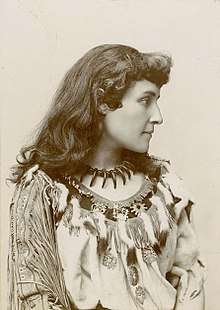
- Tammy Beauvais, Mohawk fashion designer
- Joseph Brant, Mohawk leader, British officer
- Molly Brant, Mohawk leader, sister of Joseph Brant
- Joseph Tehawehron David, Mohawk artist
- Esther Louise Georgette Deer, Mohawk dancer and singer
- Tracey Deer, Mohawk filmmaker
- John Deseronto, Mohawk chief
- Canaqueese, called Flemish Bastard, Mohawk chief
- Carla Hemlock, quilter, beadwork artist
- Donald "Babe" Hemlock, woodcarver, sculptor
- Hiawatha, Mohawk chief
- Karonghyontye or Captain David Hill, Mohawk leader
- Kahn-Tineta Horn, activist
- Kaniehtiio Horn, film and television actress
- Waneek Horn-Miller, Olympic water polo player
- Devery Jacobs, actress
- Sid Jamieson, lacrosse player, coach
- Sean St. John, banking executive
- George Henry Martin Johnson, Mohawk chief and interpreter
- Pauline Johnson, writer
- Stan Jonathan, former NHL hockey player
- Maurice Kenny, author
- Mary Leaf, basketmaker
- Dawn Martin-Hill, professor
- Derek Miller, singer-songwriter
- Patricia Monture-Angus, lawyer, activist, educator, and author.
- Alwyn Morris, Olympic K–2 1000m.
- Shelley Niro (b. 1954), filmmaker, photographer, and installation artist
- John Norton, Scottish born, adopted into the Mohawk tribe and made an honorary "Pine Tree Chief"
- Richard Oakes, Mohawk activist
- Ots-Toch, wife of Dutch colonist Cornelius A. Van Slyck
- Alex Rice, actress
- Robbie Robertson, singer-songwriter, The Band
- August Schellenberg, actor
- Jay Silverheels, actor
- Skawennati, multimedia artist and curator
- Taiaiake Alfred, professor and activist
- Saint Kateri Tekakwitha, "Lily of the Mohawks", a Catholic saint
- Billy Two Rivers, professional wrestler
Iroquoian peoples
- Cherokee
- Chonnonton
- Erie
- Huron
- Iroquois
- Meherrin
- Petun (See also Protohistory of West Virginia)
- Susquehannock
- Tuscarora (also Nottoway)
See also
- Black Indians in the United States
- Iroquois Confederacy
- Kahnawake surnames
- Mohawk language
- Native Americans in the United States
- Native American tribe
- Oka Crisis
- One-Drop Rule
- The Flying Head
Notes
- "About the Mohawk Nation Council of Chiefs". Mohawk Nation Council of Chiefs of the Haudenosaunee Six Nations Confederacy. Mohawk Nation Council of Chiefs. Archived from the original on 11 August 2014. Retrieved 4 August 2014.
- Snow, Dean R.; Gehring, Charles T.; Starna, William A. (1996). In Mohawk Country. Syracuse University Press. ISBN 0-8156-2723-8. Archived from the original on 2016-12-31. Retrieved 2016-10-11.
- Donald A. RUMRILL, "An Interpretation and Analysis of the Seventeenth Century Mohawk Nation: Its Chronology and Movements," The Bulletin and Journal of Archaeology for New York State, 1985, vol. 90, pp. 1–39
- Dean R. Snow, (1995) Mohawk Valley Archaeology: The Sites, University at Albany Institute for Archaeological Studies (First Edition); Occasional Papers Number 23, Matson Museum of Anthropology, The Pennsylvania State University (Second Edition).
- "Dutch missionary John Megapolensis on the Mohawks (Iroquois), 1644". Smithsonian Source. Archived from the original on June 11, 2016. Retrieved May 27, 2016.
- "A Short History of the Mohawk" Archived 2016-06-24 at the Wayback Machine, in In Mohawk Country: Early Narratives about a Native People, ed. Dean R. Snow, Charles T. Gehring, William A. Starna; Syracuse University Press, 1996, pp. 38–46
- William N. Fenton, Francis Jennings, Mary A. Druke: The Earliest Recorded Description. The Mohawk Treaty with New France at Three Rivers 1645, in Jennings ed., The History and Culture of Iroquois Diplomacy. Syracuse University Press, 1985, pp. 127–153
- John Demos, The Unredeemed Captive: A Family Story from Early America, New York: Alfred A. Knopf, 1994
- "The Albany Congress". Archived from the original on 7 April 2014. Retrieved 2 April 2014.
- "Little Abraham Tyorhansera, Mohawk Indian, Wolf Clan Chief". Native Heritage Project. Archived from the original on July 1, 2016. Retrieved May 26, 2016.
- Stone, William (September 1838). "Life of Joseph Brant--Thayendanegea; including the Border Wars of the American Revolution". American Monthly Magazine. 12: 12, 273–284.
- Sky Walking: Raising Steel, A Mohawk Ironworker Keeps Tradition Alive, archived from the original on 2016-11-01, retrieved 2016-10-29
- Joseph Mitchell, "The Mohawks in High Steel", in Edmund Wilson, Apologies to the Iroquois (New York: Vintage, 1960), pp. 3–36.
- Nessen, Stephen (19 March 2012), Sky Walking: Raising Steel, A Mohawk Ironworker Keeps Tradition Alive, archived from the original on 1 November 2016, retrieved 2016-10-29
- Owen, Don. "High Steel" (Requires Adobe Flash). Online documentary. National Film Board of Canada. Archived from the original on 28 December 2010. Retrieved 14 March 2011.
- Tarbell, Reaghan (2008). "Little Caughnawaga: To Brooklyn and Back". National Film Board of Canada. Retrieved August 31, 2009.
- Wolf, White. "The Mohawks Who Built Manhattan (Photos)". White Wolf. Archived from the original on 2017-10-22. Retrieved 2016-10-29.
- Wallace, Vaughn (2012-09-11). "The Mohawk Ironworkers: Rebuilding the Iconic Skyline of New York". Time. Archived from the original on 2012-09-15. Retrieved 2012-09-16.
- ROSENBLATT (12 June 2003). "3 No. 42: Saratoga County Chamber of Commerce Inc., et al. v. George Pataki, as Governor of the State of New York, et al". www.law.cornell.edu. Archived from the original on 24 October 2017. Retrieved 27 June 2017.
- see C. 590 of the Laws of 2004
- "The Associate Deputy Secretary of the Interior" (PDF). Washington. 4 January 2008. Archived (PDF) from the original on 27 March 2009. Retrieved 29 October 2010.
- "Former Website of the NYS Department of Environmental Conservation" (PDF). Archived (PDF) from the original on 6 February 2007. Retrieved 29 October 2010.
- "Warren v. United States of America, et al". Archived from the original on 1 August 2012. Retrieved 29 October 2010.
- "mohawk". Cultural Survival. Archived from the original on May 28, 2015. Retrieved May 26, 2015.
- Anderson, Emma (2013). The Death and Afterlife of the North American Martyrs. Cambridge, Massachusetts: Harvard University Press. p. 25.
- Corwin, Edward Tanjore (1902). A Manual of the Reformed Church in America (formerly Reformed Protestant Dutch Church). 1628-1902. pp. 408–410.
- Inglish, Patty (February 27, 2020). "Traditional Mohawk Nation Daily and Ceremonial Clothing". Owlcation. Retrieved 2020-08-10.
- Megapolensis, Jr., Johannes. “A Short Account of the Mohawk Indians.” Short Account of the Mohawk Indians, August 2017, 168
- Anne Marie Shimony, "Conservatism among the Iroquois at Six Nations Reserve", 1961
- "Six Nations Of The Grand River". Archived from the original on 2016-01-28. Retrieved 2007-12-16.
- "Home Page". www.wahta.ca. Archived from the original on 2019-03-27. Retrieved 2019-03-27.
- "Mohawks of the Bay of Quinte – Tyendinaga Mohawk Territory » Home". Archived from the original on 2007-09-28. Retrieved 2007-12-16.
- "She꞉kon/Greetings – Mohawk Council of Akwesasne". Archived from the original on 2007-12-26. Retrieved 2007-12-16.
- Kahnawá:ke, Mohawk Council of. "Mohawk Council of Kahnawá:ke". www.kahnawake.com. Archived from the original on 2013-09-06.
- "— ganienkeh.net-- Information from the People of Ganienkeh". Archived from the original on 2013-06-03. Retrieved 2012-12-02.
- "Kanatsiohareke Mohawk Community". Archived from the original on 2007-10-18. Retrieved 2007-12-16.
References
- Snow, Dean R. (1994). The Iroquois. Boston: Blackwell Publishers. ISBN 1-55786-938-3.
- In Mohawk Country: Early Narratives about a Native People, ed. Dean R. Snow, Charles T. Gehring, William A. Starna, Syracuse University Press, 1996
External links
| Wikimedia Commons has media related to Mohawk tribe. |
- Culture of the Haudenosaunee on the Mohawks of the Bay of Quinte website
- Akwesasne News at the Akwesasne website
- The Wampum Chronicles: Mohawk Territory articles on history and culture
- "Mohawk Institute", Geronimo Henry archived site
- The Iroquois Book of Rites by Horatio Hale, at Project Gutenberg

